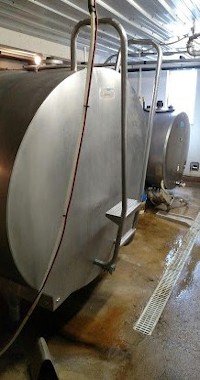By Melissa Wilson and Chryseis Modderman et.al
Market disruptions from COVID-19 are affecting dairies across the nation, forcing some farmers to dump surplus milk that cannot be processed. As a fat- and protein-rich product, proper disposal reduces the risk of environmental impacts. Two options for the milk are landspreading or adding it to manure storages. Either can be done and are good ways to recycle the nutrients in milk, but there are potential issues to be aware of. Always check local ordinances to see if either of these are allowable!
Direct land application
For the same reason milk is a valuable food product, it can be a good source of nutrients for crops. It has a high nutrient content: a University of Wisconsin report says milk has the equivalent of 46 pounds of nitrogen (N), 26 pounds of phosphorus (P2O5), and 17 pounds of potassium (K2O) per 1,000 gallons. It is different from manure, however, because many of the nutrients are in a highly soluble, plant-available form. Similar to manure, milk needs to be land-applied in a way that protects water quality. Nutrient leaching and runoff are concerns, especially this early in the year when there are not yet crops on the fields and hay pastures are not growing as actively as later in the year.
Tips:
- According to Minnesota Pollution Control Agency (MPCA) rules, the nutrients in the milk need to be accounted for in nutrient management planning. Avoid applying to fields where manure was applied this spring or the previous fall. Do not apply more nitrogen than the following crop needs.
- Collect a milk sample and send it to a lab for analysis. This way you will know how much nutrients you applied later on.
- Follow all guidelines for manure application. Do not apply the milk within required setbacks from sensitive features like water bodies, ditches, tile intakes, sinkholes, etc. Consider using larger setbacks if possible. Minimum state requirements can be found here: https://www.pca.state.mn.us/sites/default/files/wq-f8-11.pdf
- Milk will have a strong odor as it decomposes in the field. Inject or incorporate as soon as possible.
- Avoid applying milk immediately before or after a rain event. The interactive Minnesota RRAF (Runoff Risk Advisory Forecast) map can help determine when a runoff event is likely in the next 24 to 72 hours: https://www.mda.state.mn.us/rraf.
Adding milk to manure storages
If you have the space, adding the milk to manure storage may be a better option. While this will eventually end up being land applied, it gives you more time to plan for proper nutrient management.

Tips:
- The addition of milk will change the usual nutrient content of your manure. You may want to consider trying to collect a sample from your storage and send it to a lab prior to application to adjust your application rates appropriately.
- Odor production and/or how crusts form on the top of the storage will likely be impacted. This could impact how you agitate your storage later on.
- The fats in milk may plug equipment. If this happens, rinse with water often.
- Don’t have enough storage? Contact neighbors to see if they can take your milk and put it in their storage.
- Follow all MPCA rules for manure application.
Other options
Milk could potentially be added to anaerobic digesters. There is a concern that this could increase gas production, but not necessarily methane. According to the Wisconsin Department of Agriculture, Trade, and Consumer Protection (DATCP), “Exercise extreme caution if considering adding milk to anaerobic digesters. Consult the digester company before adding milk to the digester to determine appropriate volumes of milk that can be added without negatively impacting the digester’s microbial communities.”
Do not dump milk down the drain with your milkhouse wastewater. Milkhouse wastewater treatment systems are not designed to handle milk that cannot be added to the bulk tank (milk from fresh or treated cows). The biological oxygen demand (BOD) will overload the treatment system.
One final thought
According to Marin Bozic, U of M dairy economist, remember to make sure your dumped milk still counts! Keep records that include the date, volume of milk, reason for dumping, and where it was disposed of. This will help in the event that state or federal programs become available to help farmers with lost revenue during the COVID-19 pandemic.
Source : umn.edu